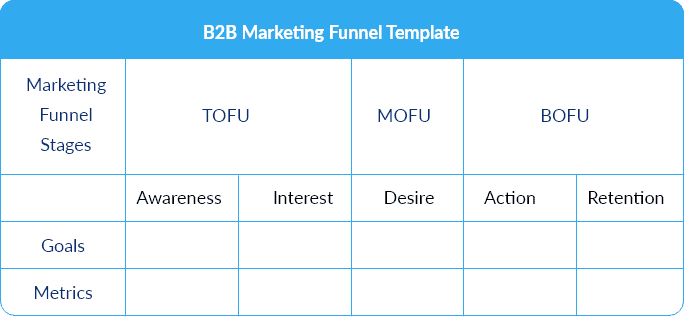Subscribe to Our Newsletter
Stay updated with the latest tips and strategies. Get additional discounts and alerts on offers.

Most marketing professionals are not confident in their current content strategy. According to SEMrush, only 9 % of marketers are 100% sure about their content strategies.
It can be challenging to answer buyer questions, address doubts and objections all in one marketing campaign. Want an effective solution that will make sure your strategy brings in more leads while lowering your cost per lead?
The solution is to build a B2B marketing funnel!
A B2B marketing funnel offers you insights into what your customers want. When you understand the needs, preferences, and pain points of your customers, you can significantly improve your marketing strategy.
Want to know more about a B2B marketing funnel and how to build a perfect B2B marketing funnel to bring in more hot leads? Read ahead!
Let’s start by understanding what a marketing funnel is, and why it is crucial for successful lead generation.
A B2B marketing funnel is a series of steps designed to attract targeted B2B leads. The primary goals of a B2B marketing funnel are to build brand awareness and enhance loyalty, while the sales funnel focuses on converting potential customers into qualified hot leads.
The marketing funnel for B2B chronicles people’s journeys from when they become customers. It outlines the marketing activities that should be implemented at each B2B marketing funnel stage.
Although a typical B2B marketing funnel takes longer than a consumer sales cycle, it’s more sustainable in the long term. It also allows you to segment your target audience into different groups for personalized marketing messaging and offers, based on where each customer is in the buyer journey. This increases the chance of sales success.
The benefits that come with building and implementing a B2B marketing funnel to attract potential buyers, are many:
A B2B content marketing funnel helps you design a map of your target audience’s buyer journey, from their very first interaction to their current position.
By utilizing this strategy, you can gain valuable insights into what your customer needs at specific points in their journey. Such insights can help you deliver what your customer requires, which in turn minimizes your customer acquisition cost (CAC).
The more recognition and recall value your brand has, the better, as it makes your brand credible. When B2B buyers are aware of who you are and what you sell, it cuts the sales cycle in half. This results in quicker conversions, boosted customer loyalty, as well as customer lifetime value (CLTV).
By building a B2B sales and marketing funnel, you can maximize traffic to your website without spending on paid ads. Additionally, more content leads to more link building opportunities, thereby supporting your brand awareness.
A B2B marketing funnel opens up various marketing opportunities for long-term revenue, as you get access to a customer’s data. This means that instead of focusing on making immediate sales, you can utilize the marketing data to personalize account-based marketing (ABM) campaigns. You show your expertise and knowledge and position your brand as an authority. So, when your B2B customers are ready to make a decision, your company will be on top of their minds.
B2B funnel marketing aids in the fostering of relationships and building brand loyalty. When you can gain access to your prospects’ contact information, you can feed them into an email nurture. This can be done by sending out email campaigns to educate potential clients, demonstrate how your products work, share case studies, offer exclusive discounts and offers.
A marketing sales funnel lets you track and measure your marketing team’s performance through B2B marketing funnel metrics. You can easily assess what works and what doesn’t to effectively adapt your strategy to get buyers moving down the funnel and boost conversion rates.
Creating a B2B marketing funnel is key to understanding the organizational buying behavior of your target audience. To understand how buyer behavior works, you can visit our article on 4 factors that influence buyer behavior. Once you recognize the pain points and motivating factors of your potential buyers, you can create an effective marketing funnel that improves your chances of making a sale.
Here are three traditional B2B marketing funnel stages:
TOFU is also called the awareness stage and is the first stage of the marketing funnel. This is where potential consumers become aware of problems within their business and start looking for solutions. They realize they have a problem but are not ready to buy yet.
At this stage, your aim should be to boost brand awareness and generate more sales qualified leads. There are many effective ways to raise brand awareness, some of which are:
Publishing free and relevant blog posts, white papers, eBooks, YouTube videos, and other informative content can help you set up thought leadership and boost brand awareness.
Social media platforms can be leveraged to share posts to engage and connect with prospective customers globally. This showcases topic authority and helps build meaningful relationships.
Running Google and social media ads online can help create brand awareness and support your organic marketing efforts.
MOFU or the consideration stage is when a customer has fully realized that they have a problem and actively seeking solutions. This is when your product can be introduced, but don’t get started on hard sales yet. This is because your prospective customers aren’t actively buying, but just browsing and looking for products available in the market.
The content and messaging of your brand will change at this stage of the B2B marketing funnel. Brand awareness and interest has already been created. So, this is when you offer your customers context for consideration.
Differentiate your product from the ones on the market by highlighting its unique value proposition and why it’s the best choice for your buyer. When you position your company’s products or services, pay attention to how they can help your ideal customers attain their goals.
The content you create at the MOFU stage will play a crucial role in pushing your prospects to the final stage of the B2B marketing funnel. Certain content types to focus on during MOFU stage are white papers, webinars, case studies, industry reports, surveys, product videos, and more.
BOFU is also known as the decision stage and represents the phase where a customer has shortlisted a few products and is ready to make a purchase decision. It’s at this stage where you get into a complete sales mode to persuade prospects to take action. This could mean a direct purchase, a consultation registration, or a free trial.
During this stage, it’s important to create educational content and messaging so your prospects don’t have any doubts in their minds while making a purchase. You can offer your prospective customers free trials, coupons and discounts, consultations, quotes and estimates, tutorials, testimonials, etc.
Now that you’ve understood the 3 stages of a B2B marketing funnel, the next step towards a successful marketing strategy is to learn about the marketing process:
The five steps to follow while creating a B2B marketing funnel are awareness, consideration, action, re-engagement, and retention.
Figure out how to drive your B2B prospects to your website. Once that is done, map the customer’s journey. Push them to sign up for your newsletter, as they are still in the TOFU stage of your B2B marketing funnel, so you can start sharing valuable content with them. Also, direct your prospect to a form to explore more about your brand.
Once your prospective customers are aware of your brand, they will consider their options. At this point, it’s necessary to get in front of your customers before your competitors do. Leverage B2B marketing funnel strategies such as entering prospective customers into a nurture campaign. Once that is done, share valuable content to highlight why your solution is the best for them.
The action stage is one of the most important stages of the B2B marketing funnel. This is where your buyer makes decisions regarding the product they want to purchase by comparing features and advantages among brands and solutions. They see which one offers the best possible combination of features and perks at the best price and take action to make it happen.
A few leads might slip away or present sales objections. You can still engage with them, foster a relationship and warm them up for the perfect time. All you’ll need to do is set up an email remarketing campaign to make sure they don’t slip away again.
The last phase is to not stop paying attention to your existing customers. Offer top-quality customer service and share content that resonates with them and keeps them engaged. This presents opportunities for upselling and encourages user referrals for new business.
Here’s an example of a B2B marketing funnel to utilize as part of your marketing strategy.

Now that you know how to build a B2B marketing funnel, you’ll require a strategy to support your lead generation process. Pinpoint the problem, agitate it, and offer a solution.
Here are some B2B marketing strategies you can utilize:
Create content that is not just valuable and informative, but also addresses the pain points of your target audience. Highlight how your solutions can solve common pain points in a better manner than your competitors. Blogs, eBooks, kits, and guides are some methods for lead nurturing via content marketing.
SEO involves using high-ranking keywords in your content to increase visibility, boost organic search traffic, build your online reputation and help maximize your B2B marketing funnel conversion rates.
Optimize TOFU content for informational queries, while focusing on commercial keywords for MOFU and BOFU content. Utilize ranking keywords into your content, meta tags, and website copy, for effective SEO.
A paid ad strategy is crucial for a B2B marketing funnel. Use Google Ads and focus on high-search keywords to retarget your website visitors and drive traffic to your landing pages. Take up attention-grabbing ad copies and use CTAs to encourage clicks and conversions.
Send personalized emails to your ideal customers to build positive customer relationships across the B2B marketing funnel. Recognize trigger points to offer value in each funnel stage.
Leverage email automation to trigger tailored emails based on lead actions, such as attending a webinar or downloading a whitepaper. Include clear CTAs in your emails to persuade leads to take the next step in the marketing funnel.
Finding and implementing tactics to enhance your B2B marketing funnel is essential to generate leads and boost conversions. DataCaptive is a powerful B2B prospecting and database provider that can help you optimize your B2B marketing and sales funnels for high ROI.
Here are some reasons why DataCaptive is the best choice for B2B marketers to find and convert ideal sales leads:
Boost your B2B marketing funnel today by procuring B2B leads from DataCaptive. Discover high-quality leads now!
A B2B marketing funnel acts as a blueprint that shows businesses what a customer goes through before making the final purchase. It reveals how they interact with the brand from the first encounter. It helps collect details of the journey people take towards becoming a brand customer.
Building a successful B2B marketing funnel can be a long process, but it gets returns just as much as the effort goes in building it. Various proven tactics and steps taken to create a B2B marketing funnel are – setting goals, identifying the audience, understanding touchpoints, implementing strategies, tracking progress, and optimizing the funnel for better conversions!
Creating a B2B marketing funnel is not as easy as it looks. Optimizing the funnel makes or breaks the marketing campaign or a marketer. With the steps discussed in this blog post, get started with precision targeting with data-driven decisions.
If you are looking for more information on how to create a perfect B2B marketing funnel, sign up for our newsletter with updates and new trends in the B2B industry and marketing!
A full funnel marketing strategy for B2B includes four stages. Among them, the first three primarily focus on attracting and acquiring new customers while the last stage’s primary role is to retain customers and sustain their loyalty. They are namely TOFU (prospect generation), MOFU (lead generation), BOFU (conversion), and post-funnel retention.
The top of the marketing funnel, where millions of prospects enter, is referred to as TOFU. This occurs when a customer encounters the brand for the first time, initiating their introduction to the brand and its products and services. The main goal at this stage is to create brand awareness and generate prospects.
Understanding the customer’s journey can be complicated. However, with both B2B marketing and sales funnels, you can integrate the results, truly understand the journey map, and optimize the funnels for smooth transitions. Simply put, you can quickly gather more insights into the customer journey and your next line of action required.
B2B marketing funnel metrics are crucial for marketers to utilize. They provide valuable insights into campaigns and customer behavior. These metrics encompass volume, velocity, and conversion rates.

Emails

Contact Numbers

C-Level Executives

Company Profiles
Show Some Love!

Subscribe to Our Newsletter
Stay updated with the latest tips and strategies. Get additional discounts and alerts on offers.
Related Articles
Subscribe to Newsletter
Stay up to date with the latest marketing, sales, and service tips and news.
